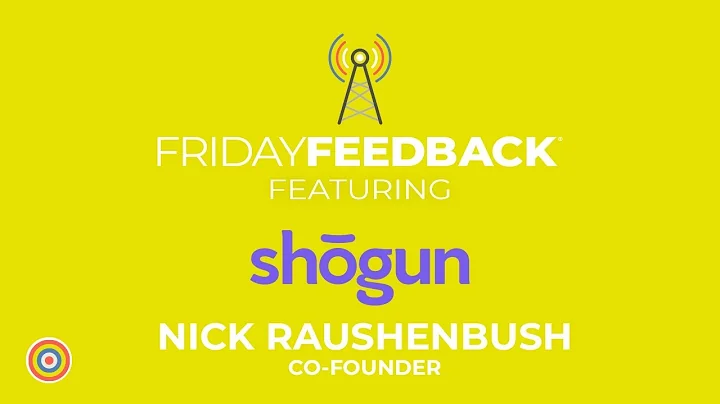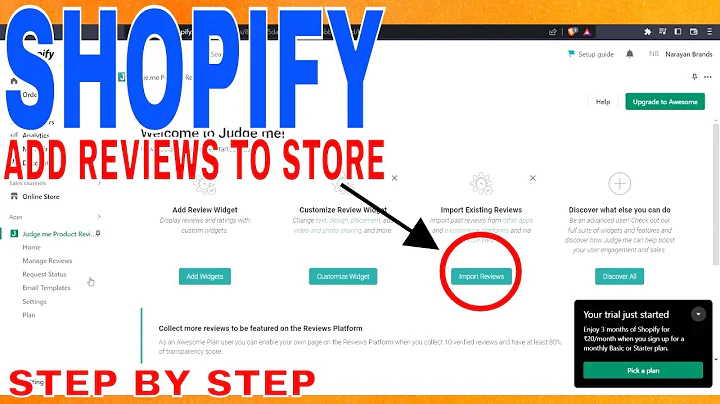Master Shopify Liquid: An In-Depth Guide
Table of Contents
- Introduction
- Shopify Liquid: An Overview
- Variables in Liquid
- Control Flow in Liquid
- For Loops in Liquid
- Filters in Liquid
- Working with Assets in Liquid
- Snippets and Sections in Liquid
- Accessing Data in Liquid
- Next Steps
Shopify Liquid: An Overview
Shopify Liquid is a versatile templating engine used in Shopify themes. Whether you are new to theme development or an experienced developer, this guide will provide you with the necessary knowledge to work effectively with Shopify Liquid. In this article, we will cover the basics of Shopify Liquid, including variables, control flow, for loops, filters, working with assets, snippets and sections, and accessing data. So, let's dive in and explore the power of Shopify Liquid!
1. Introduction
Shopify Liquid is the templating engine used in Shopify themes. This article serves as an introduction to Shopify Liquid, covering all the important aspects for beginners and experienced developers alike.
2. Shopify Liquid: An Overview
Liquid is a powerful templating engine that allows you to generate dynamic content in Shopify themes. In this section, we will explore its features, syntax, and functionality.
3. Variables in Liquid
In this section, we will learn about the two main ways to create variables in Liquid: using the assign keyword and the capture tag. We will also cover the different data types that can be assigned to variables.
Pros:
- Variables provide flexibility and dynamic content generation.
- Easy creation and manipulation of data.
Cons:
- No direct support for arrays.
4. Control Flow in Liquid
Control flow statements allow you to perform conditional checks and execute different code blocks based on specific conditions. In this section, we will explore the if-else statements, unless statements, and case statements in Liquid.
Pros:
- Enables conditional logic and dynamic content generation.
- Allows for multiple condition checks.
5. For Loops in Liquid
For loops are a powerful tool for iterating over collections, such as products, tags, or collections. In this section, we will learn about for loops and how to use them to loop through Shopify data.
Pros:
- Allows for easy iteration over collections.
- Enables dynamic content generation based on the number of items in a collection.
Cons:
- Nested for loops can lead to complex code structures.
6. Filters in Liquid
Filters in Liquid allow you to transform and manipulate data. In this section, we will explore various filters, including string filters, money filters, and image filters, and learn how to apply them in Liquid code.
Pros:
- Provides a convenient way to modify and format data.
- Saves time by handling data transformations within Liquid.
Cons:
- Some filters may not be suitable for all use cases.
7. Working with Assets in Liquid
Assets, such as images, scripts, and stylesheets, are an essential part of a Shopify theme. In this section, we will learn how to work with assets in Liquid and how to include them in your theme.
Pros:
- Allows for easy inclusion of assets in your theme.
- Simplifies management of image paths and assets.
8. Snippets and Sections in Liquid
Snippets and sections are reusable code blocks that help you organize and modularize your Shopify theme. In this section, we will explore how to create and include snippets and sections in your theme.
Pros:
- Enables code reusability and organization.
- Helps maintain a clean and modular theme structure.
9. Accessing Data in Liquid
Liquid provides several predefined objects that allow you to access and utilize Shopify data. In this section, we will explore how to access data objects and use them to generate dynamic content.
Pros:
- Provides access to a wide range of Shopify data.
- Enables dynamic content generation based on product and collection attributes.
10. Next Steps
Congratulations! You now have a solid understanding of Shopify Liquid and its various features. In this final section, we will discuss the next steps you can take to further expand your knowledge and enhance your Shopify theme development skills.
Article
Shopify Liquid: An Overview
Shopify Liquid is a versatile templating engine used in Shopify themes. Whether you are new to theme development or an experienced developer, this guide will provide you with the necessary knowledge to work effectively with Shopify Liquid.
Introduction
Liquid is a powerful templating engine that allows you to generate dynamic content in Shopify themes. It provides a simple and intuitive syntax for manipulating data and creating customized templates. In this article, we will cover the basics of Shopify Liquid, including variables, control flow, for loops, filters, working with assets, snippets and sections, and accessing data. By the end of this guide, you will have a solid understanding of Shopify Liquid and be ready to create stunning and functional Shopify themes.
Shopify Liquid: An Overview
Liquid is the templating engine used in Shopify themes. It allows you to dynamically generate content based on predefined templates and data. Liquid provides a straightforward and easy-to-understand syntax, making it accessible to developers of all skill levels. Whether you are creating a simple theme or a complex e-commerce website, Liquid offers the flexibility and power you need to create stunning Shopify themes. In this section, we will explore the features, syntax, and functionality of Shopify Liquid, providing you with a comprehensive overview of this powerful tool.
Variables in Liquid
In Liquid, variables are used to store and manipulate data. There are two main ways to create variables in Liquid: using the assign keyword and the capture tag. The assign keyword is used to assign a value to a variable, while the capture tag is used to capture and assign a block of text to a variable. Liquid supports various data types, including strings, numbers, and booleans. However, it does not have built-in support for arrays.
Control Flow in Liquid
Control flow statements allow you to perform conditional checks and execute different code blocks based on specific conditions. Liquid provides several control flow statements, including if-else statements, unless statements, and case statements. These statements enable you to create dynamic content based on user-defined conditions. With control flow statements, you can display different content, perform calculations, and customize your themes to suit your specific needs.
For Loops in Liquid
For loops are an essential tool for iterating over collections in Liquid. Whether you want to display a list of products, loop through collections, or generate dynamic content based on tags, for loops provide the necessary functionality. In Liquid, for loops are used to iterate over arrays, allowing you to access each item in the collection individually. By using for loops, you can easily generate dynamic content based on the data in your Shopify store.
Filters in Liquid
Filters in Liquid allow you to transform and manipulate data. Whether you need to format strings, convert currencies, or resize images, filters provide a convenient way to modify your data. Liquid offers a wide range of filters that can be applied to variables, strings, numbers, and other data types. By using filters, you can customize the appearance and behavior of your data, ensuring that it meets the specific requirements of your Shopify theme.
Working with Assets in Liquid
Assets, such as images, scripts, and stylesheets, are an integral part of any Shopify theme. Liquid provides several ways to work with assets, including the use of asset URLs and tags for images, scripts, and stylesheets. By leveraging these features, you can easily include and manipulate assets in your theme. Whether you need to display images, add custom scripts, or style your theme with CSS, Liquid provides the necessary tools to integrate assets seamlessly into your Shopify themes.
Snippets and Sections in Liquid
Snippets and sections are reusable code blocks that help you modularize your Shopify theme. Snippets are HTML partials that can be included in multiple templates, allowing you to reuse code and improve code organization. Sections, on the other hand, provide a way to organize and structure your theme by defining reusable sections of content. By utilizing snippets and sections, you can create cleaner, more modular code that is easier to maintain and update.
Accessing Data in Liquid
Liquid provides several predefined objects that allow you to access and utilize Shopify data. These objects, such as products, collections, and tags, provide access to important information about your store. By accessing these objects, you can create dynamic content and display relevant information to your customers. Whether you want to display product details, list collections, or showcase tagged items, Shopify Liquid provides the necessary tools to access and utilize your store's data.
Next Steps
Congratulations! You now have a solid understanding of Shopify Liquid and its various features. In this guide, we covered the basics of Shopify Liquid, including variables, control flow, for loops, filters, working with assets, snippets and sections, and accessing data. Armed with this knowledge, you are ready to create stunning and functional Shopify themes. To further enhance your skills, consider exploring more advanced topics, such as metafields, theme customization, and app integrations. Keep practicing and experimenting, and soon you will be able to create tailor-made Shopify themes that exceed your clients' expectations.
Highlights
- Shopify Liquid is a powerful templating engine used in Shopify themes.
- Liquid allows you to generate dynamic content, manipulate data, and create customized templates.
- Variables in Liquid can be created using the
assign keyword or the capture tag.
- Control flow statements, such as
if-else statements and case statements, enable the creation of dynamic content based on specific conditions.
- For loops in Liquid are used to iterate over collections and generate dynamic content based on the data.
- Filters in Liquid provide a convenient way to transform and manipulate data, such as formatting strings and converting currencies.
- Working with assets in Liquid allows you to include and manipulate images, scripts, and stylesheets in your Shopify themes.
- Snippets and sections provide reusable code blocks that improve code organization and modularity.
- Liquid provides predefined objects that allow you to access and utilize Shopify data, such as products, collections, and tags.
- The next steps include exploring more advanced topics, such as metafields, theme customization, and app integrations.
FAQ
Q: Can I use Liquid in any other platform besides Shopify?
A: Liquid was originally created by Shopify and is primarily used in their platform. However, there are some other platforms that have adopted Liquid for their templating needs.
Q: Is Liquid difficult to learn for beginners?
A: Liquid has a straightforward and easy-to-understand syntax, making it accessible to developers of all skill levels. With some practice and experimentation, beginners can quickly grasp the basics of Liquid.
Q: Can I use Liquid to create custom themes for Shopify stores?
A: Yes, Shopify Liquid is the recommended templating engine for creating custom themes for Shopify stores. It provides the necessary tools and flexibility to create unique and visually appealing themes.
Q: Are there any limitations to what can be done with Liquid?
A: While Liquid is a powerful templating engine, it does have some limitations. For example, Liquid does not have built-in support for arrays, and certain complex operations may require additional customization or integration with other technologies.
Q: Can I use Liquid for frontend development?
A: Liquid is primarily used for backend development in Shopify themes. However, it can be used in combination with HTML, CSS, and JavaScript to create fully functional and interactive frontend experiences.
Q: Can Liquid be used outside of Shopify?
A: Liquid was specifically designed for use within the Shopify platform and its ecosystem. While it can technically be used outside of Shopify, it may require additional customization and integration to work in other environments.






















